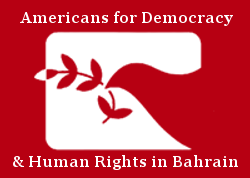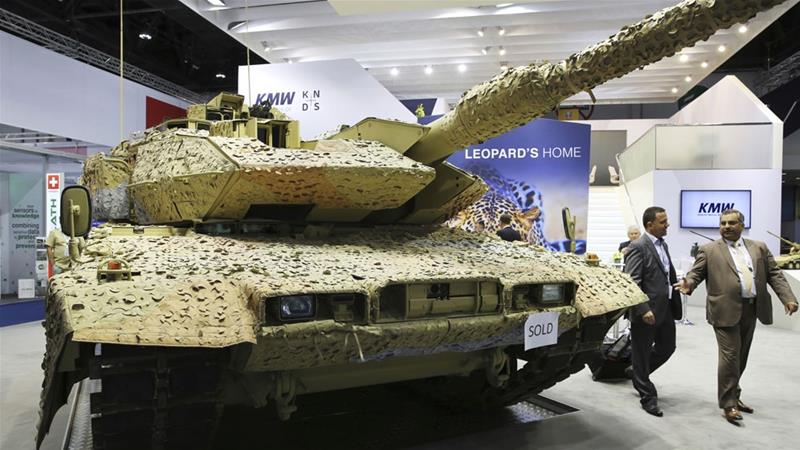Official databases show that Germany is one of the largest arms exporters in the world. The arms export industry is a major economic driver of the German economy, peaking in 2015 amounting to just under €8 billion a year turnover.
On the surface, Germany’s rhetoric appears to try and avoid its arms exports being used directly or indirectly in armed conflicts that infringe upon human rights and international humanitarian law. Yet in practice, the country is unwilling to implement its own arms sales restrictions enacted in relation to atrocities taking place in Yemen. In fact, research carried out by Amnesty International and Human Rights Watch, as well as newspapers such as DW indicate that German arms have continued to surface in the bloody conflict.
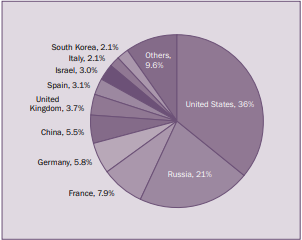
The Stockholm International Peace Research Institute (SIPRI), which publishes research on conflicts, armaments, arms control and disarmament, reported in Trends in International Arms Transfers that Germany was the fourth largest arms exporter between the period of 2015 to 2019. Another report of the organization issued in March 2020, exposed the rise in Germany’s arms export by 17% compared to the previous period of 2010-2014. Within the last five years, the country reached €8.5 billion in arms transfer which accounts for 5.8% of the global total arms sales. According to recent statistics, Germany made 1.1 billion Euros from arms exports in relation to a GDP of € 3.4 trillion in 2019. (This number was converted from US Dollars).
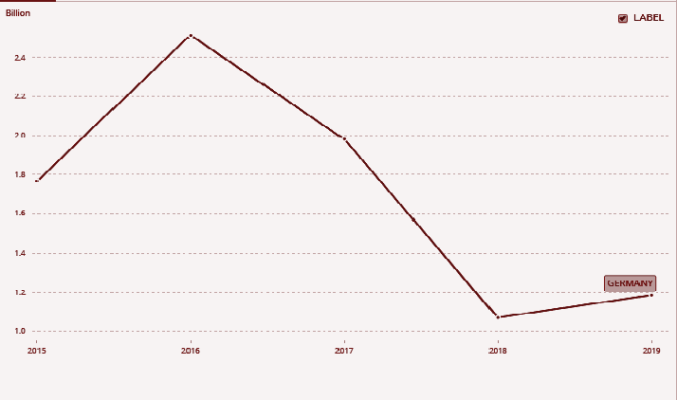
Despite continuous promises to reduce Germany’s arms exports, the industry’s output has continued to rise every other year since reunification in 1990, and above the value of arms exports approved by the government. In fact, Germany imposed an arms embargo after the killing of journalist Jamal Khashoggi by Saudi authorities. However, it later eased its restrictions mainly because such measures annoyed France and Britain, whose giant arms makers required German components that were banned. On the other hand, German media outlet DW reported in March 2020 that the German government had approved an extension of the arms embargo on Saudi Arabia, which will now last until December 31, 2020.
An arms embargo would cause serious complications to Saudi Arabia’s military abilities as it is among the top ten biggest German arms importers in the world. Easing the restrictions on that embargo would consequently facilitate human rights abuses in the Gulf region and the wider Middle East. For instance, since 2015, Saudi Arabia has spearheaded a coalition campaign against the Houthi rebels in Yemen, causing one of the gravest humanitarian crises in the world. Furthermore, Saudi Arabia is also militarily involved in Middle Eastern conflicts—such as providing support for rebel groups in Syria, attempting to use military assistance to gain influence in Lebanon and fighting Shiite minority groups in the eastern province of Saudi Arabia.
The graph below shows the Middle East’s Military Expenditure percent in 2017 in which Saudi Arabia claims the top spot. Military Expenditure data from SIPRI entails all capital expenditures on the armed forces, including not only military but civil personnel such as peacekeeping forces, all government agencies engaged in defense projects, paramilitary forces aimed to military operations, military space activities, retirements pensions of military personnel and social services for personnel, military aid, etc. The military expenditure focus on the region reveals the outcome wave of conflicts still today going on in the Middle East – with much of it explained by the Iran-Saudi Arabia rivalry. Many conflicts in the region have been directly supported or indirectly sponsored by these two states, increasing regional tensions between Sunni-Shia populations across the Muslim world.
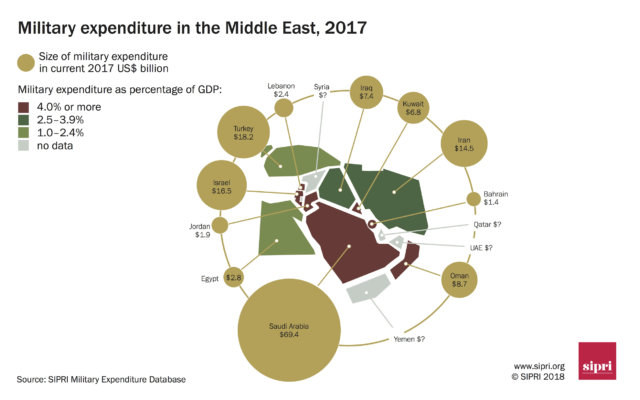
Overall, 24% of german arms exports are sent to the Middle East. Of which, a major share was received by Saudi Arabia – which in the past ten years has remained as one of the largest importers of Germany’s weapon sales. In Trend Indicator Values (TIV) terms, SIPRI reported, in one of its importers/exporters examination tables, that between 2014 and 2019 Saudi Arabia has received a total of 343 million German arms exports.
The following graph shows how the arms sales have oscillated among 2015 and 2019. Despite the 2018 ban or arms sales to Saudia Arabia and the slightly noticeable decrease, the country has always remained as the biggest customer in the Gulf Region.
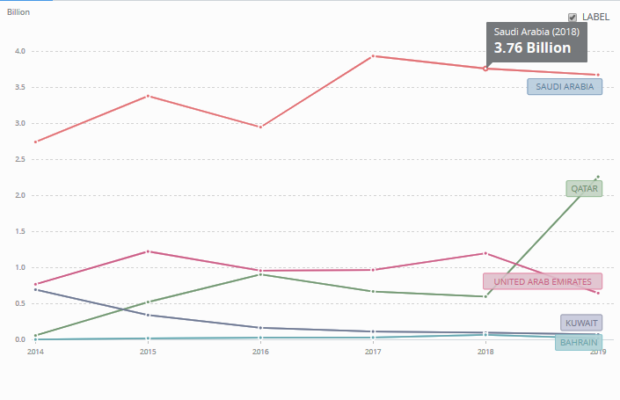
The German broadcasting service Deutsche Welle – DW has further reported in 2018, that Saudi Arabia has been one of Germany’s top clients. From September to October of the same year, Germany reached the number of €416.4 million in arms sales. In October only, exports were worth €254 million euros. Consequently, in 2018’s range of arms sales exports, Saudi Arabia stayed as Germany’s third-biggest customer following Algeria and the United States.
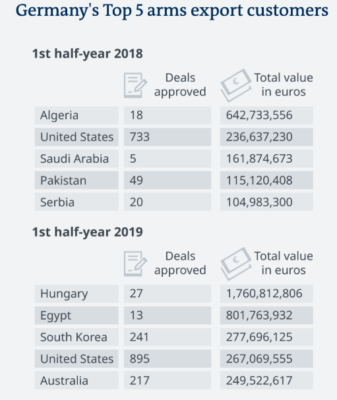
Germany made international headlines by restricting arms transfers to countries directly involved in the Yemen war, following the reports outlining the widespread and systematic abuses perpetrated by the Saudi-led coalition. Further, the news around the killing of the Saudi journalist, Jamal Khashoggi in 2018, pushed the EU parliament to call on its member states to impose an arms embargo on Saudi Arabia. Following the international pressure, Germany agreed to a temporary moratorium on arms sales to Saudi Arabia, which was extended in March 2019 for an additional six months. Nonetheless, evidence shows that since its introduction, the pledge for restricted arms sales and the suspension of future licenses to countries having a direct role in the Yemen conflict has failed to be 100% implemented, rendering the original pledge as disingenuous.
Amnesty International reported in 2018 that most countries, including Germany, that promised to ban arms transfers to Saudi Arabia have never been actually implemented. A German disarmament specialist, Sevim Dagdalen had exposed that certain future deals were still on the negotiating table. Since early 2019, Dagdalen reported that Germany approved the export of €1 billion worth of German weapons to Egypt, the United Arab Emirates, and other members of the Saudi-led coalition in Yemen. Additionally, it was no secret that the country continued to sell partially German-made weapons to Saudi Arabia. Weapons and vehicles such as the Eurofighter plane and the MBDA ground-to-air missile systems are built by a consortium of European companies that includes Germany.
Saudi Arabia is not the only country beneficiary from a loose implementation of the arms trade restriction. Other members of the Saudi-led coalition have also secured arms transfer deals in the past two years. Since 2019, Germany has exported arms worth €1 billion to the same Saudi-led military coalition. The German Government granted €257 million to the UAE which, according to an expert panel from the UN, has exacerbated the war in Yemen by committing human rights and humanitarian law violations. Next to the United Arab Emirates, Egypt remains one of the biggest importers of German military equipment amounting to €800 million worth in sales. The country has recently bought missiles, rocket parts, and target acquisition systems and a submarine from the German company, ThyssenKrupp Marine Systems.
The reason behind the vindication of these above-mentioned deals becomes clear from Angela Merkel’s statement, following the approval of an arms deal to Saudi Arabia in 2019. The Chancellor maintained that the systems and projects Germany had agreed upon before the ban must be followed-through, so as to ensure that Germany would remain a truthful partner to countries in trade partnerships. The softening of the ban can be explained when regarding political pressure exercised by the United Kingdom and France due to previously existing agreements concerning arms transfer and arms exports. In January 2019, France and Germany decided that no state should block the arms exports of the other if the proportion of the components would not exceed 20% of the total volume. Consequently, Germany has justified the circumvention of the ban appealing to the importance of economic cooperation. With this statement, it is clear that the German Chancellor places more onus on the economic reasons for the cessation of arms deals with belligerent countries, and not the disastrous humanitarian crisis that has been unfolding in Yemen since 2015.
Germany failed to adhere to its promises to restrict arms sales to countries involved in the Yemen war. Despite official statements and international pressure, weapon sales to Saudi Arabia, which is engaged exacerbating in the Yemen conflict, has never truly stopped. Once again, economic interests seem to trump the importance of internationally recognized humanitarian law and human rights. Yet Germany continues to hypocritically praise itself in its supposed role in ending the Yemen humanitarian crises by restricting the arms transfers to the region – but it is clear that these arms deals have never been completely prohibited. Germany continues to find alternative, indirect ways to ensure it still profits from the sale of arms exports.

